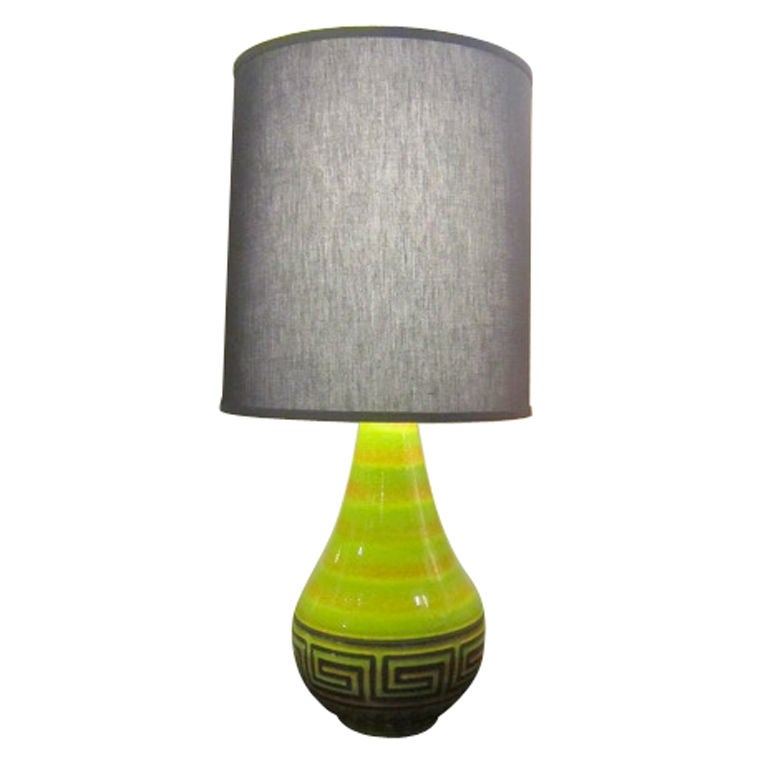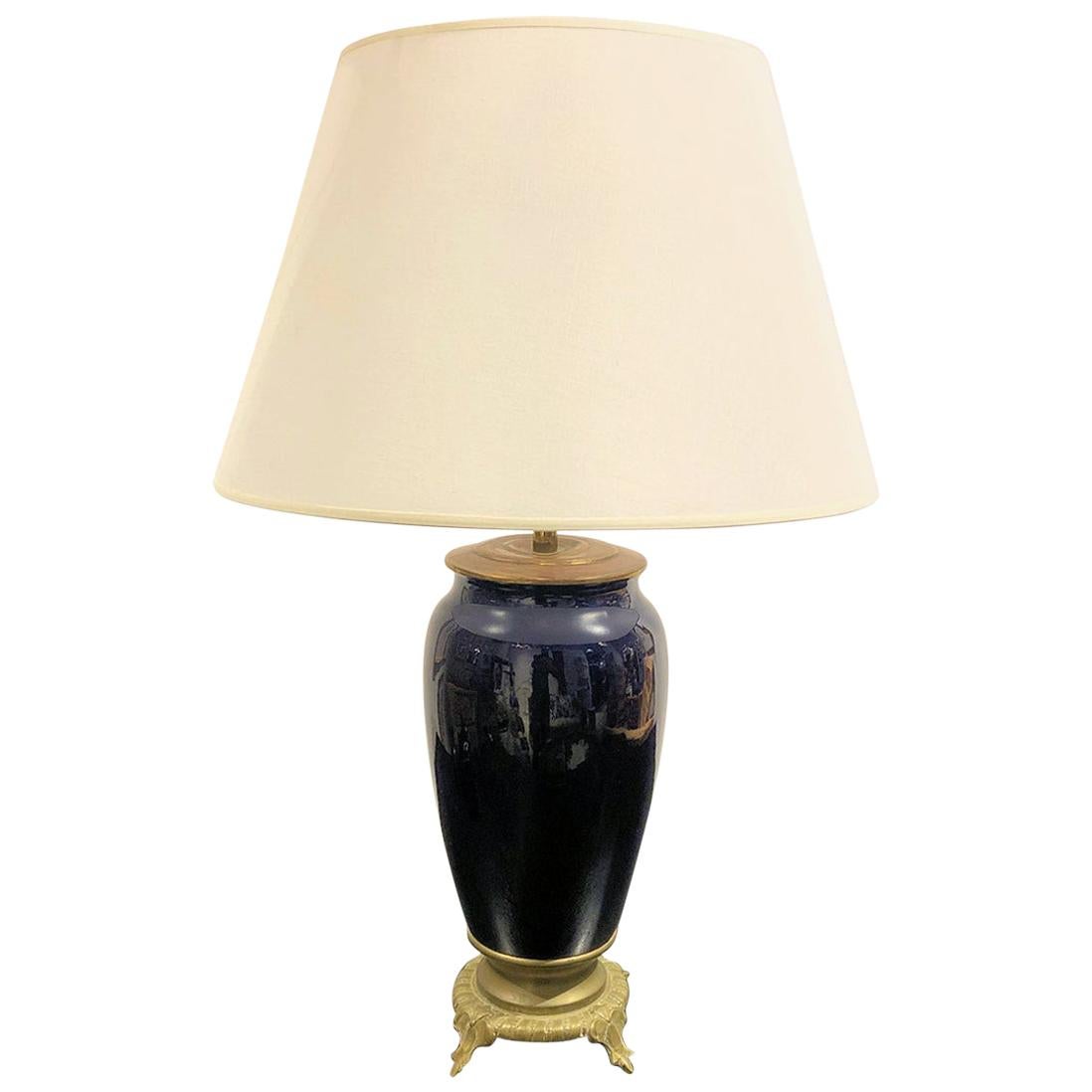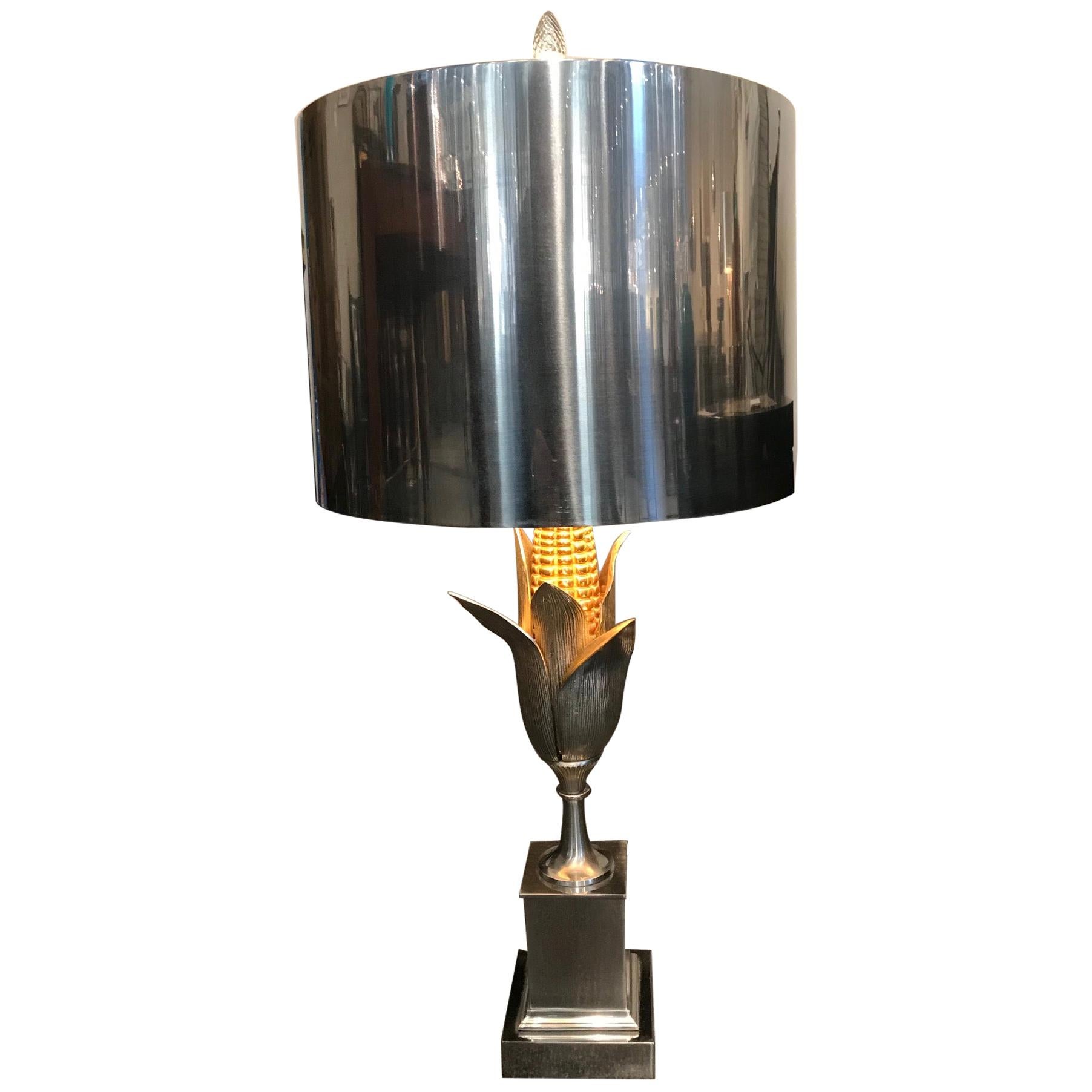Items Similar to Table Lamp in Ceramic and bronze, Sign: Elchinger Fils Soufflenheim Alsace
Video Loading
Want more images or videos?
Request additional images or videos from the seller
1 of 21
Table Lamp in Ceramic and bronze, Sign: Elchinger Fils Soufflenheim Alsace
About the Item
Desk lamp
Sign: Elchinger Fils Soufflenheim Alsace.
Céramique Elchinger is a ceramics factory located in Soufflenheim in Alsace, which operated from 1834 to 2016. Before 1834, the company was a small tile factory founded by Michel Elchinger around 1792 on the same site.
Céramique Elchinger is a family business that Wendelin Elchinger (1809-1895) founded in 1834 on the current site. He transformed the tile factory inherited from his father, which was founded around 1792. The production was initially dedicated to culinary pottery. One of his sons, Philippe (1842-1906), succeeded him and, from 1870 onwards, developed an outdoor ornamental pottery focused on garden and façade elements.
His son Léon Elchinger (1871-1942) left a legacy of work.
In 1889, he was at the École des Beaux-Arts in Nancy; in 1890 in Germany at Höhr-Grenzhausen for the technical part. Until 1892, he made his tour of France as a companion. From 1892 to 1893, he was commissioned to decorate the façade of the new school at the École supérieure des arts décoratifs in Strasbourg, where he was a student. On this occasion, he created fabulous ceramic panels and thus signed, at the age of 21, his first work. He made numerous study trips to England, Hungary and Italy and returned to Soufflenheim to give a new impetus to his workshops.
He embarked on artistic ceramics. His works, especially flamed sandstone, were highly noticed at the beginning of the century at numerous international exhibitions. Several museums have acquired it.
The factory developed an Art Nouveau and Art Deco style and then, from 1930 onwards, produced numerous works of religious statuary.
His son Fernand Elchinger (1911-1975) took over the business in 1936, expanded and modernised the factory and built a second one in 1975 on another site. He installed the first six-pass continuous fire electric furnace built in France and thus industrialized an earthenware production.
Above all, he strengthened the manufacture of the ceramic saturator under the Hygra1 brand to bring it to a production of 1 million pieces per year, thus becoming the leading manufacturer in Europe.
Driven by the craze for Vallauris ceramics, the Alsatian manufacture became very famous for its productions from the 1950s and 1960s. These creations, vases and jugs with their refined shapes, were distinguished from the exuberant creations of the workshops of the South.
From 1975 to the present day, the Elchinger dynasty is represented by Marc Elchinger2.The production is resolutely oriented towards high-end tableware and home décor. Internationally renowned designers create colourful ranges that are always on trend. In addition, the company, which is very attached to its regional culture, has been publishing for the past fifteen years the original and exclusive versions of the watercolours by Jean-Jacques Waltz, known as "Hansi".
Thibaut Elchinger3 is now the sixth generation of ceramists. Since 2008, the company has been called "Elchinger Couturier de la Terre". The Céramique Elchinger brand is still used for its licensed productions (Hansi, etc.) and other subcontractors and the Elchinger Couturier de la Terre brand for its contemporary collections.
On 7 May 2001, the company was placed in receivership.
On December 4, 2002, it obtained the signature of a continuation plan.
On 14 April 2008, it was placed in compulsory liquidation.
The factory closed its doors for good on June 30, 2016 after more than 200 years of existence and eight generations.
Leading ceramists
Fernand Elchinger (ceramist 1911-1975)
Léon Elchinger (ceramist 1871-1942)
From 1893 he worked in the family pottery in Soufflenheim and produced ceramics for interior ornamentation and architectural ceramics. The main Alsatian ceramist of the first half of the twentieth century.
Philippe Elchinger (1836-1906)
Wendelin Elchinger (1809-1895)
We have specialized in the sale of Art Deco and Art Nouveau and Vintage styles since 1982. If you have any questions we are at your disposal.
Pushing the button that reads 'View All From Seller'. And you can see more objects to the style for sale.
Why are there so many antiques in Argentina?
In the 1880 – 1940 there was a grate wave of immigration encouraged by the periods of war that were taking place.
1st World War took place between 1914 and 1918
2nd World War took place between 1939 and 1945
The immigrants options were New York or Buenos Aires. Tickets were cheap and in Buenos Aires they were welcomed with open arms, as it was a country where everything was still to be done.
Argentina was the country of new opportunities, labour was needed and religious freedom was assured, in many cases the of the family travel first until they were settled and then the rest of the family members join them.
In the immigrant museum “Ellis Island Immigrant Building” in New York you can se the promotional posters of the boats that would take them to a new life.
Between the years 1895 and 1896, Argentina had the highest DGP (gross domestic product) per capita in the world according to the Maddison Historical Statistics index, this situation arose due to the large amount of food being exported to European countries, which were at war.
The Argentinean ships left the port of Buenos Aires with food, but they returned with furniture, clothes and construction elements, (it´s common to see this the old buildings of the historic neighbourhood of San Telmo, the beams with the inscription “Made in England)”, as well as many markets that were built in Buenos Aires, such us the San Telmo Market, whose structure was brought by ship and afterwards assembled in 900 Defensa Street.
With the great influence of European immigrants living in the country, the children of the upper classes travelled to study in France, resulting in the inauguration of “La Maison Argentinienne”, on 27th of June 1928, in the international city of Paris, which hosted many Argentinians that were studying in Frace.
It´s the fourth house to be built after France, Canada and Belgium, being the first Spanish-speaking one. Still in place today (17 Bd Jourdan, 75014, Paris, France). Many of the children of these wealthy families who attended international art exhibitions, museums and art courses abroad, took a keen interest in the European style. This is why Buenos Aires was at the time referred as “The Paris of South America”.
Between the years 1890 and 1920 more than a hundred Palaces were built on Alvear Avenue the most exclusive avenue in Buenos Aires. Today some of these palaces have been transformed into museums, hotels and embassies.
In the year 1936, the Kavanagh building was inaugurated, it was the tallest reinforced concrete building in South America.
During 1994 the American Society of Civil Engineers distinguished it as an “international engineering milestone”, and it´s now considered a World Heritage of Modern Architecture.
At the time was common to hire foreign architects such as Le Corbusier, who visited Buenos Aires/Argentina in 1929 and in 1948 he drew up the blueprints for a house built in La Plata City (which was declared a World Heritage Site).
In 1947, the Hungarian architect Marcelo Breuer designed “Parador Ariston” in the seaside city of Mar del Plata. After an Argentinean student at Harvard University convinced him to come to Argentina. He worked on an urban development project in the Casa Amarilla, area of La Boca.
The Ukrainian architect, Vladimiro Acosta, arrives in Argentina in 1928 and worked as an architect until que moved to Brazil.
Antonio Bonet, a Spanish architect who worked with Le Corbusier in Paris, arrives in Argentina in 1937, where he carried out several architectural works and in 1938 designs the well-known BFK chair.
Andres Kálnay, of Hungarian origin, made around 120 architectural masterpieces, among which the former Munich brewery stands out, he even made the furniture’s design.
The German architect, Walter Gropius, director of the Bauhaus, lived in Argentina, where he wrote articles for “Sur” magazine and founded in Buenos Aires, an architectural firm with Franz Möller, who was also an architect, where he built two houses.
At the same time several famous designers decided to immigrate to Argentina, among them we can find the well-known French designer, Jean-Michel Frank, who arrived in the country in 1940 and also worked for the Rockefeller family.
Special pieces were made, which were sold exclusively in the country, such as the well-known German company “WMF”, who sold their products by catalogue, which were chosen by the ladies of high society in the list of wedding gifts, as well as the pieces designed by Christofle.
The Swiss sculptor Alberto Giacometti, made special pieces for Argentinean mansions.
In 1904 the first Jansen branch outside Paris was established in Buenos Aires, as the Argentinean clientele demanded a large amount of furniture, from the end of the 19th century to the mid-20th century.
In 1970, the brand Rigolleau Argentina made pieces authorised by Lalique.
The brands Maple and Thompson also set up shop in the country.
The French plastic artist, Marcel Duchamp moved to Argentina in 1918-1919.
Glass signed Gallé, Charder, Leverre, Schneider, Muller and other French firms. They were bought in flower shops and were given to ladies with beautiful floral arrangements.
Some furniture manufacturers travelled to international fairs and bough the patterns to produce the furniture in Argentina, such as the furniture firm Englander and Bonta, who bought the patterns ins Italy.
It is worth mentioning that in Argentina we have the largest community of Italians outside of Italy, as it is estimated that 70 percent of the inhabitants have at least one Italian descendant, followed by Spanish immigrants.
The most Important furniture stores in Argentina:
Comte is founded in 1934 (under the direct management of Jean Michel Frank in 1940).
Nordiska (Swedish company established in 1934).
Churba in 1960, a company that brought foreign designers to present their furniture in the country:
Denmark: (Arne Jacobsen, Finn Juhl, Bender Madsen, Ejner Larsen, Poul Kjaerholm, Hans Wegner)
Sweden: (Hans Agne Jakobsson, Gustavsberg)
United States: (Herman Miller)
Finland: (Lisa Johansson, Folke Arstrom, Tapio Wirkkala, Alvar Aalto, Timo Sarpaneva)
Swedish Factory: (Orrefors)
Italy: (Littala, Vico Magistretti, Emma Gismondi, Gae Aulenti, Angelo Mangiarotti, Elio Martinelli, Gianna Celada, Angelo Mangiarotti, Mario Bellini, Carlo Scarpa)
Finland: (Olivia Toikka)
Plata Lappas (Lappas Silver): a goldsmith shop founded in 1887 in Argentina by Alcibiades Lappas of Greek origin.
In 2019, in Argentina took place “the Art Deco world congress”, in which we participated as hosts invited by Geo Darder, founder of the Copperbridge – Foundation, in which prominent people from all over the world attended to learn about Art Deco in Argentina.
Argentina currently has more than 100 Art Deco buildings and another 90 Art Nouveau buildings throughout the city of Buenos Aires.
Argentina is a country that has not been involved in many wars, which is why it has been a refuge for works of art and antiques from different periods of time, unlike European countries. That is way many collectors, museums and antique dealers from all over the world visit it, you should not miss the opportunity to visit this great country.
Laura Guevara Kjuder, architect.
- Dimensions:Height: 19.49 in (49.5 cm)Diameter: 5.52 in (14 cm)
- Power Source:Plug-in
- Voltage:220-240v
- Lampshade:Not Included
- Style:Art Nouveau (Of the Period)
- Materials and Techniques:
- Place of Origin:
- Period:1900-1909
- Date of Manufacture:1900
- Condition:Wear consistent with age and use.
- Seller Location:Ciudad Autónoma Buenos Aires, AR
- Reference Number:
About the Seller
5.0
Vetted Seller
These experienced sellers undergo a comprehensive evaluation by our team of in-house experts.
Established in 1982
1stDibs seller since 2022
21 sales on 1stDibs
Typical response time: <1 hour
- ShippingRetrieving quote...Ships From: Ciudad Autónoma Buenos Aires, Argentina
- Return PolicyThis item cannot be returned.
More From This SellerView All
- Art Deco Table Lamp, Denmark, 1920 in CeramicLocated in Ciudad Autónoma Buenos Aires, CTable lamp Art deco Materia: Ceramic Style: Art Deco To take care of your property and the lives of our customers, the new wiring has been done. If you want to live in the golden ye...Category
Vintage 1920s Danish Art Deco Table Lamps
MaterialsCeramic
- Art Deco Table Lamp, Czechoslovakia, 1920 in CeramicLocated in Ciudad Autónoma Buenos Aires, CTable lamp Art deco Materia: Ceramic Style: Art Deco Country: Czechoslovakia To take care of your property and the lives of our customers, the new wiring has been done. If you want ...Category
Vintage 1920s Czech Art Deco Table Lamps
MaterialsWood, Ceramic
- Jugendstil, Art Nouveau, Liberty -Table Lamp, 1900, Materials: Bronze and glassLocated in Ciudad Autónoma Buenos Aires, CTable lamp "Jugendstil, Art Nouveau, Liberty" Materia: bronze and art glass Country: France We have specialized in the sale of Art Deco and Art Nouveau and Vintage styles since 1982...Category
Vintage 1920s French Art Nouveau Table Lamps
MaterialsBronze
- Table Lamp, 1950, Material: CeramicLocated in Ciudad Autónoma Buenos Aires, CDesk lamp We have specialized in the sale of Art Deco and Art Nouveau and Vintage styles since 1982. If you have any questions we are at your disposal. Pushing the button that reads...Category
Vintage 1950s Danish Mid-Century Modern Table Lamps
MaterialsCeramic
- Art Deco Table Lamp Design: Wmf, 1920, in Silver Bronze and GlassBy WMF Württembergische MetallwarenfabrikLocated in Ciudad Autónoma Buenos Aires, CTable lamp Art deco Materia: silver bronze and glass Style: Art Deco Country: German To take care of your property and the lives of our customers, the new wiring has been done. We ...Category
Vintage 1920s German Art Deco Table Lamps
MaterialsChrome
- Table Lamp, 1900, Silver Plated Metal, Sign: Rouseau / MullerBy Muller FrèresLocated in Ciudad Autónoma Buenos Aires, CTable lamp "Jugendstil, Art Nouveau, Liberty" Materia: silver plated metal and art glass Country: France Glass: Muller To take care of your property and the lives of our customers, ...Category
Vintage 1920s French Art Nouveau Table Lamps
MaterialsArt Glass
You May Also Like
- Elchinger Table LampBy ElchingerLocated in Brooklyn, NYSigned Elchinger ceramic table lamp from the 1950'sCategory
Vintage 1960s French Table Lamps
MaterialsCeramic
- Large Elchinger Two-Tone Yellow & Black Ceramic Table Lamp, France 1950'sBy ElchingerLocated in New York, NYLarge two Tone Elchinger Biomorphic ceramic lamp in classic fifties form. 19x4x8 Base OnlyCategory
Mid-20th Century French Mid-Century Modern Table Lamps
MaterialsCeramic
- Ceramic signed table lampLocated in grand Lancy, CHBlue ceramic table lampCategory
Vintage 1950s European Table Lamps
MaterialsCeramic
- A ceramic signed table lampBy Atelier Cerenne of VallaurisLocated in Saint-Ouen, FRA 1950 ceramic tableCategory
Mid-20th Century French Modern Table Lamps
MaterialsCeramic
- Blue Ceramic and Bronze Table LampLocated in Dallas, TXSingle Mid-Century Modern dark blue ceramic and bronze base table or desk lamp, France, 1950s Sold without the shade. The vintage lamp has two lights, and is rewired for the US. Diam...Category
Vintage 1950s French Mid-Century Modern Table Lamps
MaterialsBronze
- Brass and Gilt Bronze “Corn” Table Lamp by Maison Charles et FilsBy Maison CharlesLocated in Montreal, QCBrass and gilt bronze “Corn” table lamp by Maison Charles. Signed Charles & Fils Made in France.Category
Vintage 1950s French Table Lamps
MaterialsBronze
Recently Viewed
View AllMore Ways To Browse
Casal Pottery
Lamps In The Style Of Giacometti
Brazilian Tile
1920s Antique Half Table
Herman Miller Antique Desk
Miss Trip Chair
Outdoor Concrete French
Antique Ladies Desk Chair
Spanish Dining Chairs Set Of Eight
Antique School Desk And Chair
Antique School Desk Chair
Concrete Statuary
1940s Maple Dining Table
1920s Desk Chair
Aalto Desk Chair
Spanish Travel Desk
Sets Of 14 Antique Dining Chairs
Brazilian Mid Century Outdoor





